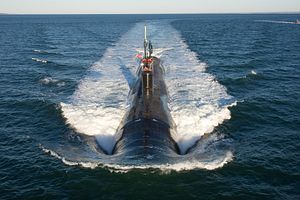The U.S. Navy is looking into the possibility of building three instead of two new nuclear-powered Virginia-class attack submarines (SSN-774) per year, military.com reports. The reason is simple: with older Los-Angeles-class fast-attack submarines (built between 1972 and 1996) retiring at a faster pace than Virginia subs are added, the U.S. Navy will face a shortfall in the number of active vessels in the near future.
This projected deficit is not news and was already predicted by analysts as far back as 1995, given the U.S. Navy’s current requirement of deploying an average of 10 nuclear-powered attack submarines (SSNs) on a day-to-day basis.
Given this deployment schedule, the navy must maintain a fleet of 48 SSNs over the next few decades. However, beginning in 2025, active SSNs will gradually drop below that number and eventually bottom out at 41 in 2029, which implies a shortfall of seven boats that year. Based on the U.S. Navy’s current 30-year SSN procurement plan, this gap will exist for 12 years until 2041, when the number of SSNs will finally be back at 48.
“We are going to drop below the minimum requirement of 48 (attack submarines) even with the two per year build rate – so we’ve got to sustain that two-per year build rate and figure out ways to work through that trough, or a low point. Unfortunately, we will go down to 41 SSNs at one point,” Rear Adm. Joseph Tofalo, Director of Undersea Warfare, stated.
The Congressional Research Service expressed a similar concern in a recent report: “The Navy’s FY2016 30-year SSN procurement plan, if implemented, would not be sufficient to maintain a force of 48 SSNs consistently over the long run.”
Consequently, Tofalo sent an inquiry about the prospect of accelerating construction to the naval shipyards tasked with building the boats and is expecting an answer by the end of May. In the 1980s, U.S. shipbuilders were able to launch four vessels per year, the Rear Admiral notes:
The biggest issue is finding the man power pool in an economy that is also coming back. That is probably the biggest challenge. During the decade of the 80s this country built three SSNs (attack submarines) and one SSBN (ballistic missile submarine) every year for about a decade. This country can do amazing things when challenged.
As of now, the U.S. Navy fields 55 SSNs including 41 Los-Angeles-class, three Seawolf-class, and 11 Virginia-class boats, according to the Congressional Research Service. There are talks about extending the life cycle of some SSNs by ten or more years (between 2002 to 2008, the U.S. Navy already turned four of its oldest Ohio-class SSBNs into SSGNs), or more interestingly, revising the U.S. Navy’s operational requirements.
After the navy succeeded in removing about $400 million from the cost of each submarine, the price per vessel is now at about $2 billion. However, the navy is now planning to add up to 28 additional Tomahawk cruise missiles to each Virginia-class sub by installing the so called Virginia Payload Module (see: “US Subs Getting Fire Power Boost”).
The Congressional Research Service states that adding the Virgina Payload Module (VPM) to the Virgina-class “might increase their unit procurement costs by about 13 percent.”
SSNs are multipurpose vessels and can perform a variety of missions including intelligence collection, covert insertion of special operations forces, land strikes, as well as anti-submarine and anti-surface warfare.
Of course, the larger question behind the issue of the number of deployed SSNs is what the genuine operational requirements of the United States Navy in the first half of the 21st century should be in times of fiscal austerity.
































